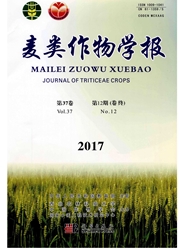

 中文摘要:
中文摘要:
为给小麦面条品质改良提供理论依据,以4个携带全部3个Wx蛋白亚基的普通小麦品种为试材,检测其籽粒灌浆期淀粉合成关键酶活性的动态变化,并对籽粒淀粉理化特性和面条加工品质进行比较。结果表明,籽粒灌浆过程中,济麦19和济麦20的淀粉粒束缚淀粉合成酶(GBSS)活性明显较低,而参与支链淀粉合成的关键酶如ADP-葡萄糖焦磷酸化酶(AGPase)、可溶性淀粉合成酶(SSS)和淀粉分支酶(SBE)活性差异不明显,最终其籽粒直链淀粉含量显著低于鲁麦14和鲁麦21,面粉膨胀势、糊化峰值粘度和崩解值较高,面条加工品质优良。淀粉合成关键酶活性与直、支链淀粉增长速率显著相关,说明遗传背景不同是造成淀粉合成和最终加工品质差异的重要原因。不同淀粉合成关键酶活性之间密切相关,说明参与淀粉合成的酶是相互影响、共同作用的;直、支链淀粉增长速率高度相关,说明二者的合成是相互制约、同步进行的。携带全部3个Wx蛋白亚基的普通小麦品种的GBSS活性可以存在显著差异,从而形成不同的淀粉理化特性和面条加工品质,因此完全有可能在不缺失Wx蛋白的普通小麦中选育出优质面条品种。参与淀粉合成的关键酶是相互影响的,单独改变一种或几种淀粉合成关键酶的表达或活性,可能对淀粉品质的遗传改良作用较小。
 英文摘要:
英文摘要:
In order to provide reference to genetic improvement of wheat noodle quality,the activities of starch biosynthetic enzymes at grain-filling stage were investigated in grains of 4 wheat cultivars carrying all 3 Wx proteins subunits,which controlling the synthesis of amylose,starch physiochemical properties and noodle quality.Results showed that the activity of granule-bound starch synthase(GBSS) in developing endosperm from Jimai19 and Jimai20 was significantly lower than that of Lumai14 and Lumai21,while the activities of other key enzymes involved in amylopectin biosynthesis were similar,such as ADP-glucose pyrophosphorylase(AGPase),soluble starch synthase(SSS),and starch branching enzyme(SBE).Therefore,Jimai19 and Jimai20 exhibited lower amylose content in grain,and higher flour swelling power,pasting peak viscosity and breakdown,as well as better noodle quality.Activities of starch biosynthetic enzymes were correlated significantly with accumulating rate of amylose and amylopectin during grain filling,which suggested wheat cultivars were different in starch biosynthesis and processing quality mainly due to genotype.The activities of enzymes involved in starch biosynthesis were correlated significantly in developing endosperm,which indicated that they interacted in starch biosynthesis,the same was as accumulation of amylose and amylopectin.It is possible to breed wheat cultivars for preferred noodle quality from wild common wheat without Wx protein deficiency,and modification in activity or expression of one and several enzymes might not improve starch properties greatly.
 同期刊论文项目
同期刊论文项目
 同项目期刊论文
同项目期刊论文
 期刊信息
期刊信息
